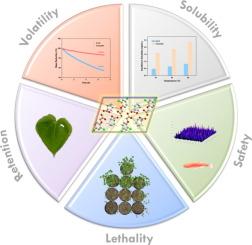Eco-friendly 2,4-D ionic cocrystal with enhanced release and reduced non-target losses
IF 13.3
1区 工程技术
Q1 ENGINEERING, CHEMICAL
引用次数: 0
Abstract
The low solubility and high volatility of 2,4-D pose significant challenges for effective herbicide delivery and ecological harmony. Organic cocrystal engineering has gained prominence as a versatile method to improve pesticide properties, characterized by ease of preparation, proven effectiveness, low cost, and scalability. In this work, we report an organic ionic cocrystal of 2,4-D with DL-proline, where both molecules self-assemble through hydrogen bonding in the crystal lattice, with DL-proline maintaining its zwitterionic form. Compared to pure 2,4-D, the cocrystal reduces volatility by over 70 % while exhibiting excellent stability at room temperature. Furthermore, the cocrystal enhances the release profile of the active compound across a range of temperatures (15 °C, 25 °C, 35 °C), with a solubility increase of more than 2.8-fold. Moreover, the cocrystal reduces the evaporation rate of the solution, leading to a longer retention time on leaf surfaces. In terms of herbicidal efficacy, the cocrystal provides equivalent weed control at just 1/4 of the dosage required for pure 2,4-D. Additionally, it exhibits reduced toxicity to zebrafish and human hepatocytes and cardiomyocytes. This work underscores the significant potential of organic cocrystal engineering in improving multiple herbicide properties and highlights its relevance for the development of advanced agrochemical products.

环保的2,4- d离子共晶,具有增强的释放和减少非目标损失
2,4- d的低溶解度和高挥发性给除草剂的有效施用和生态和谐带来了重大挑战。有机共晶工程作为一种改善农药性能的通用方法,其特点是制备容易、有效、低成本和可扩展性。在这项工作中,我们报道了一种与dl -脯氨酸的有机离子共晶体,其中两个分子通过晶格中的氢键自组装,dl -脯氨酸保持其两性离子形式。与纯2,4- d相比,该共晶降低了70% %以上的挥发性,同时在室温下表现出优异的稳定性。此外,共晶增强了活性化合物在温度范围内(15 °C, 25 °C, 35 °C)的释放谱,溶解性提高了2.8倍以上。此外,共晶降低了溶液的蒸发速率,导致在叶片表面停留的时间更长。在除草功效方面,共晶提供了同等的杂草控制只需1/4的剂量所需的纯2,4- d。此外,它对斑马鱼和人类肝细胞和心肌细胞的毒性降低。这项工作强调了有机共晶工程在改善多种除草剂性能方面的巨大潜力,并强调了其与先进农化产品开发的相关性。
本文章由计算机程序翻译,如有差异,请以英文原文为准。
求助全文
约1分钟内获得全文
求助全文
来源期刊

Chemical Engineering Journal
工程技术-工程:化工
CiteScore
21.70
自引率
9.30%
发文量
6781
审稿时长
2.4 months
期刊介绍:
The Chemical Engineering Journal is an international research journal that invites contributions of original and novel fundamental research. It aims to provide an international platform for presenting original fundamental research, interpretative reviews, and discussions on new developments in chemical engineering. The journal welcomes papers that describe novel theory and its practical application, as well as those that demonstrate the transfer of techniques from other disciplines. It also welcomes reports on carefully conducted experimental work that is soundly interpreted. The main focus of the journal is on original and rigorous research results that have broad significance. The Catalysis section within the Chemical Engineering Journal focuses specifically on Experimental and Theoretical studies in the fields of heterogeneous catalysis, molecular catalysis, and biocatalysis. These studies have industrial impact on various sectors such as chemicals, energy, materials, foods, healthcare, and environmental protection.
 求助内容:
求助内容: 应助结果提醒方式:
应助结果提醒方式:


